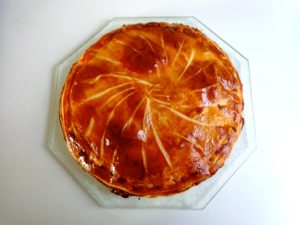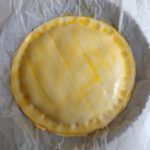
Kings cake
This cake of puff pastry filled with frangipane is enjoyed in France on or around Jan. 6 to mark the Christian festival of Epiphany. Sold in bakeries at often exorbitant prices, it can easily be made at home. The only question is whether or not to include a fève — dried bean — that will designate who gets to wear a paper crown for finding it (see below).
As an everyday French chef, I recommend using commercial puff pastry (pâte feuillétée if in France). Be sure to buy a brand made with butter rather than vegetable shortening. If you prefer to make the pastry yourself, there are many recipes available online. But be forewarned — it’s a bit of a production.
The frangipane is an almond cream, lighter than almond paste, that you will mix up yourself using powdered almonds. It is flavored with vanilla, and you can also add another flavor if you like — rum, cognac, almond extract or rose water, for example.
In addition to the ingredients listed below, you will need a 9-10 inch (23-25 cm) cake or pie tin to use for tracing your circles of dough, a pastry brush, a rolling pin and some parchment paper. The cake will serve 6-8 people.
2 ounces (60 g) unsalted butter (about half a stick), at room temperature
1/2 cup (125 g) sugar
2 eggs plus 1 egg yolk
1-1/2 cup (150 g) powdered almonds
1 tsp. vanilla extract or 1 packet vanilla sugar
1 tbsp. rum or another flavoring (optional, see above)
2 rolls puff pastry
Begin by making the frangipane (almond) filling. Cut the butter into pieces and transfer to a medium bowl. Add the sugar. Beat until well creamed together.
Add the 2 eggs. Beat again until smooth. Add the powdered almonds and flavorings and beat again. The mixture should be light and creamy. Set aside.
Preheat the oven to gas mark 6 (350 F, 180 C).
Make an egg wash in a small cup by combining the egg yolk with 1 tsp. water. Set aside.
Place a sheet of parchment paper over a large board. Unroll one puff pastry sheet onto the paper. Sprinkle lightly with flour, and flour your rolling pin. Roll over the pastry lightly.
Invert a 9-10 inch (23-26 cm) cake or pie tin over the dough. Following the outline of the pan, trace through the dough with a sharp knife. Pull away and remove the excess dough. Lift up the tin. You should now have a perfect circle of dough.
Transfer this first dough circle to a baking sheet covered with parchment paper. Spoon the almond filling onto the middle of the dough. Spread it around with the back of a spoon, leaving an empty margin of about 1 inch (2.5 cm) around the border.
Paint a little of the egg wash over the margin with a pastry brush.
Now make another dough circle as described above. Place it on top of the cake. Press the edges of the dough together, moving around the circle with your two forefingers.
 Paint the entire surface of the cake with the egg wash.
Paint the entire surface of the cake with the egg wash.
Using a very sharp knife, trace patterns over the cake, being careful not to pierce the dough. You can trace rounded lines from the edges to the middle, as shown in the photo at top. Or you can trace vertical lines across the cake, give it a one-third turn and trace straight lines one more time to create a diamond pattern.
Place the cake in the oven and bake for about 30 minutes, until golden. Cool on a rack.
Serve warm or at room temperature. Serves 6-8.
Note: Traditionally a dried broad bean was concealed in the filling. Whoever was served the piece with the bean became king (or queen) for a day and received a paper crown. These days, the bean is usually replaced by bakeries with a porcelain or plastic figure.
If you’d like to follow this tradition, simply place a large dried bean in the filling before you cover the cake with the second circle of dough. To make the paper crown, cut a long strip of tissue paper about 3 inches (8 cm) wide. Cut zigzags along one side of the strip. Tape the two ends of the strip together to form a head-sized crown.




